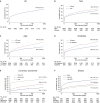Trends in Clinical Practice and Outcomes After Percutaneous Coronary Intervention of Unprotected Left Main Coronary Artery
- PMID: 35350870
- PMCID: PMC9075483
- DOI: 10.1161/JAHA.121.024040
Trends in Clinical Practice and Outcomes After Percutaneous Coronary Intervention of Unprotected Left Main Coronary Artery
Abstract
Background The use of percutaneous coronary intervention (PCI) to treat unprotected left main coronary artery disease has expanded rapidly in the past decade. We aimed to describe nationwide trends in clinical practice and outcomes after PCI for left main coronary artery disease. Methods and Results Patients (n=4085) enrolled in the SCAAR (Swedish Coronary Angiography and Angioplasty Registry) as undergoing PCI for left main coronary artery disease from 2005 to 2017 were included. A count regression model was used to analyze time-related differences in procedural characteristics. The 3-year major adverse cardiovascular and cerebrovascular event rate defined as death, myocardial infarction, stroke, and repeat revascularization was calculated with the Kaplan-Meier estimator and Cox proportional hazard model. The number of annual PCI procedures grew from 121 in 2005 to 589 in 2017 (389%). The increase was greater for men (479%) and individuals with diabetes (500%). Periprocedural complications occurred in 7.9%, decreasing from 10% to 6% during the study period. A major adverse cardiovascular and cerebrovascular event occurred in 35.7% of patients, falling from 45.6% to 23.9% (hazard ratio, 0.56; 95% CI, 0.41-0.78; P=0.001). Radial artery access rose from 21.5% to 74.2% and intracoronary diagnostic procedures from 14.0% to 53.3%. Use of bare-metal stents and first-generation drug-eluting stents fell from 19.0% and 71.9%, respectively, to 0, with use of new-generation drug-eluting stents increasing to 95.2%. Conclusions Recent changes in clinical practice relating to PCI for left main coronary artery disease are characterized by a 4-fold rise in procedures conducted, increased use of evidence-based adjunctive treatment strategies, intracoronary diagnostics, newer stents, and more favorable outcomes.
Keywords: PCI; unprotected left main coronary artery disease.
Figures







Comment in
-
Is Percutaneous Coronary Intervention Now the Default Revascularization Strategy for Unprotected Left Main Coronary Artery Stenosis?J Am Heart Assoc. 2022 Apr 5;11(7):e025748. doi: 10.1161/JAHA.122.025748. Epub 2022 Mar 30. J Am Heart Assoc. 2022. PMID: 35352567 Free PMC article. No abstract available.
References
-
- Mäkikallio T, Holm NR, Lindsay M, Spence MS, Erglis A, Menown IBA, Trovik T, Eskola M, Romppanen H, Kellerth T, et al. Percutaneous coronary angioplasty versus coronary artery bypass grafting in treatment of unprotected left main stenosis (NOBLE): a prospective, randomised, open‐label, non‐inferiority trial. Lancet (London, England). 2016;388:2743–2752. doi: 10.1016/S0140-6736(16)32052-9 - DOI - PubMed
-
- Serruys PW, Morice MC, Kappetein AP, Colombo A, Holmes DR, Mack MJ, Ståhle E, Feldman TE, van den Brand M, Bass EJ, et al. Percutaneous coronary intervention versus coronary‐artery bypass grafting for severe coronary artery disease. N Engl J Med. 2009;360:961–972. doi: 10.1056/NEJMoa0804626 - DOI - PubMed
-
- Buszman PE, Kiesz SR, Bochenek A, Peszek‐Przybyla E, Szkrobka I, Debinski M, Bialkowska B, Dudek D, Gruszka A, Zurakowski A, et al. Acute and late outcomes of unprotected left main stenting in comparison with surgical revascularization. J Am Coll Cardiol. 2008;51:538–545. doi: 10.1016/j.jacc.2007.09.054 - DOI - PubMed
Publication types
MeSH terms
LinkOut - more resources
Full Text Sources
Medical
Miscellaneous

